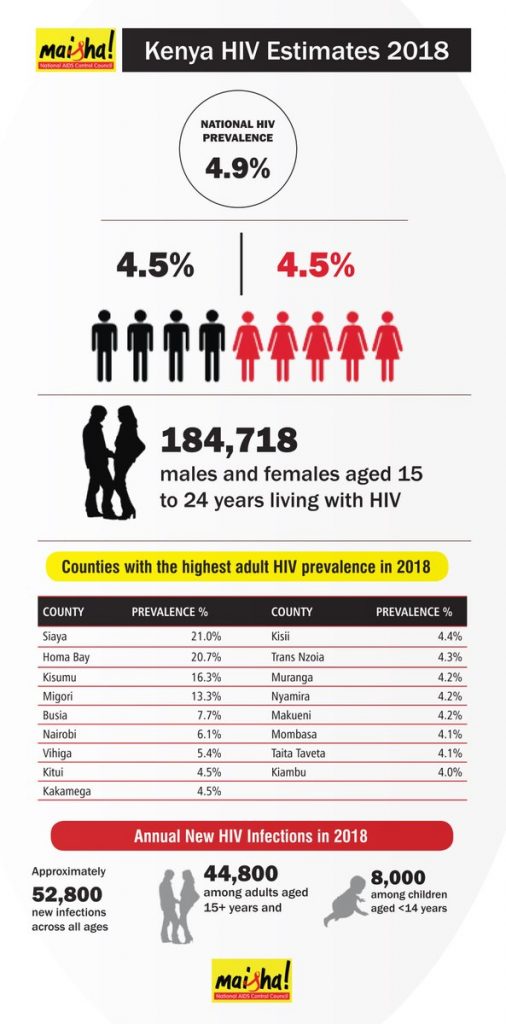“No one is immune from HIV. Not you, not me—irrespective of whether you are rich or poor. But we can protect ourselves and our loved ones. And we can show compassion for all people living with HIV,” UNAIDS Executive Director, Michel Sidibé.
Saturday, December 1, 2018, will be a day many will be refreshing their collective memories about the prevalence of the scourge amongst us and an eye opener of what remains to be done to reduce its incidence.
All will be aimed at improving universal access and according to the basic rights of HIV victims while also giving an impetus to prevention, treatment, care and support for HIV victims.
“Kenya is at 90:90:90 on global target: 75% know their HIV status, 83% are on treatment, 72% virally suppressed,” according to the National Aids Control Council (NACC).
The biggest challenge is the first 90, knowing HIV status,” they add, coinciding with the country’s theme ‘Know your HIV status: Mwanaume Jipime Jijue’ where a majority have the least knowledge of HIV status and retention in care among men.
In the 2018 Kenya Aids Response Progress Report, youth, especially females aged between 15 and 24, account for one-third of the 44,789 new HIV adult infections.
The NACC report shows that total new infections stand at 52,767 annually, including 7,978 children, translating to 14,929 girls aged between 15 and 24 who were infected in 2017.
New HIV infections justify that prevention mechanism to curb the scourge are effective, but a lot needs to be done and urges everyone to do more because new infections justify an increase in knowledge about HIV, changes in social norms and the adoption of safer behaviours.

Joshua Gitonga, the head of Monitoring and Evaluation at NACC, says, “This target group lacks comprehensive knowledge of HIV and does not have access to prevention methods because the majority rely on guardians for all their health issues.”
However, according to the report, it can be said that most HIV-positive adults were unaware of their status, implying that they may not only be unknowingly spreading the virus but are also not using any anti-retroviral medication.
If the above statistics are anything to go by, then, within the regions mentioned, it is a national disaster with far-reaching socio-economic implications.
What does this mean to the realization of Vision 2030? In clear terms, this means it can easily be bogged down by the HIV/AIDS burden if people are not sensitized to respond to the measures that mitigate the scourge.
The HIV program in Kenya aims to contribute to the country’s targets documented in ‘Kenya’s Vision 2030” through universal access to comprehensive HIV prevention, care, and treatment.
Key initiatives include reducing HIV infections, AIDS-related mortality and stigma and increasing domestic financing for the HIV response.
As we mark World AIDS Day, the challenge is keeping the uninfected population negative.
This population is the youth, and we need to redouble our efforts in supporting the government in attaining the 2030 vision of reducing the prevalence to less than 2%.
The challenges affecting the youth are massive. Our communities and government will only hope for better days if they take solid steps to empower the youth to realize their potential by supporting them because they contribute towards HIV prevention.
Young people are leading the prevention revolution by taking definitive action to protect themselves from HIV. A change is happening among young people across the world.
Youths demand prosperity, employment, health, lifestyle, and a friendly environment, yet HIV/AIDS and other diseases, climate change, unfavourable policies and lack of self-awareness lead them to noninvolvement in development activities.
These are becoming the main stumbling blocks which lead youths to engage in criminal activities such as abusing drugs, prostitution, robbery, alcoholics, and other antisocial behaviours.
Today, the death rate of those infected with HIV/AIDS has drastically reduced with the use of antiretroviral(ARV) drugs.
“With the ART coverage scaled up to 75%, the AIDS-related deaths have been noted to have declined significantly to below 30,000, resulting in 635,600 deaths averted, setting the country on the path towards achieving the 9090-90,” says Sicily Kariuki, Cabinet Secretary, Ministry of Health.
However, the survey statistics hit heavily with the highest rate in urban towns.
Well aware of these, the government and other stakeholders have said prevention efforts should focus more on the youth.
As the community, we should be ready to stand out and address the issue. This is because limited budgets, problems imposed by the HIV epidemic and few health care providers mean improving reproductive health services is challenging for Kenya.
Therefore, we need to join hands in initiating programmes to educate the young or leave them to face a bleak future.
Most young people still do not have access to the information, skills, services or social support required to enable them to prevent HIV infection.
It is critical that scaling up reproductive health education and services need to be a priority for empowering young people to prevent sexual and other transmissions of HIV infection among their peers.
Sex education provides young people with the information they need to positively understand their bodies and gender roles.
Educating our young people about themselves sends a message of self-appreciation and self-esteem and highlights the fact that the change they are experiencing or would experience is indeed normal.
In conclusion, the social development of young people is a product of family and society partnership, where these children are active participants in their own lives.




